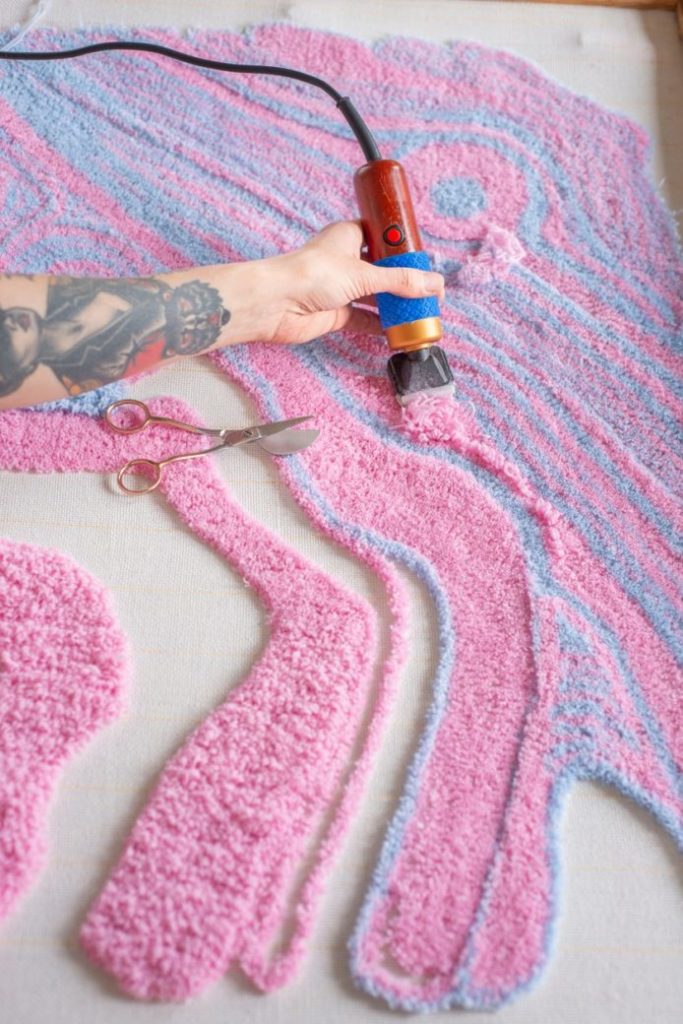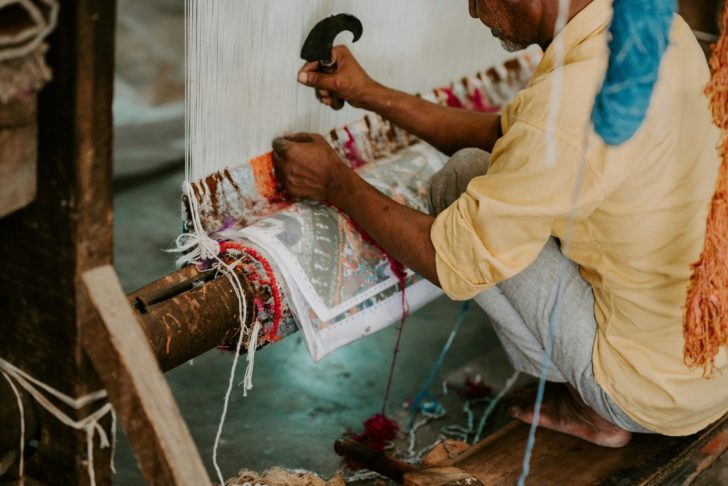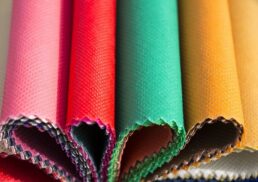Are you ready to dive into the vibrant world of rug tufting and create your very own stunning, one-of-a-kind piece? Rug tufting is an exciting and rewarding craft that allows you to bring your unique designs to life. In this comprehensive guide, we will explore the ins and outs of rug tufting, from understanding the process to choosing the right tools and materials. So, let’s get started and embark on this creative adventure together!
Table of Contents
Key Takeaways
Explore the exciting world of rug tufting with manual and automatic guns!
Discover unique yarns, fabrics & techniques to create beautiful rugs.
Join an online community for resources, tutorials & guidance!
Understanding Rug Tufting

Rug tufting is a fascinating technique in rug-making. It involves creating loops of yarn through a base foundation material, such as burlap, linen, or monks cloth. Creating loops of yarn is a time consuming task but this amazing process can be made more convenient by using a tufting gun. This specialized machine makes it faster and easier than traditional hand-tufting techniques. Embarking on your tufting venture requires a tufting gun, primary backing fabric, yarn, a robust frame, latex glue, and a secondary backing. Once you have your supplies ready, creating a tufted rug is as simple as tufting, gluing, and backing and finishing your piece.
While designing your rug, keep in mind the level of detail and its intended use. For rugs that will be used frequently, a design with less detail is recommended for easier creation using tufting frames. However, if your rug is intended as one of the wall hangings, you can indulge in more intricate designs without worrying about fibers moving with use. To transfer your design onto the fabric, use a projector or draw it freehand for the best results, especially when working with multiple strands of yarn in rug tufting.
Types of Tufting Guns: Manual and Automatic
Rug tufting guns come in numerous intriguing types such as:
Manual
Automatic cut pile
Automatic loop pile, perfect for creating a loop pile rug
Automatic cut and loop pile
Tufting guns work by feeding yarn through a hollow needle that penetrates the stretched backing fabric, allowing you to adjust the length of the loops and create a variety of textures. Prices for tufting guns can start at $275 for a local maker and around $150 for a Chinese vendor, with the maximum pile length for an automatic cut pile machine being 18mm or roughly 3/4 inch.
When choosing a tufting gun, consider the type of piles you want to create and your budget. The AK-I cut pile machine is renowned for its excellent performance. It is one of the most popular options available. If you desire piles greater than 20mm, you’ll need to opt for a pneumatic machine instead.
With the right tufting gun in hand, you’ll be well on your way to creating beautiful, unique rugs.
Building Your Tufting Frame
A robust tufting frame, built using carpet grippers and sturdy materials like wood, is crucial for successful rug tufting. When determining the size of your frame, consider the dimensions of your backing material to minimize waste and ensure enough space to clamp the fabric in place. Stability is key, so make sure your frame is rock solid and consider adding feet or leaning it against a wall to prevent it from falling over during the tufting process.
Woodworking is easy when it comes to building the frame! Constructing the frame doesn’t require too much effort. You need a square to make the right angle cut in your beams. You can use a tenon, a bracket or simply screw the pieces together; don’t forget to drill holes for a firmer connection and avoid splitting. To attach the backing fabric to the frame, a common solution is to use a staple gun, making sure to tightly increase the tension bit by bit with enthusiasm.
Primary Backing Fabric Selection
For a successful rug tufting project, it is imperative to choose the appropriate primary backing fabric. Exciting possibilities for backing materials include burlap, linen, and monks cloth. Monks cloth is a popular choice due to its lines, which prevent distortion when tension is applied. If you’re on a budget, burlap is a more affordable option that still provides a suitable foundation for your tufted rug. You can find great offers for tufting cloths on websites like Amazon.com.
With the right backing fabric, you’ll have a solid foundation for your rug, ensuring a quality finished product. Take the time to research and select the best material for your needs, and you’ll be one step closer to creating your amazing tufted rug.
Yarn Choices for Rug Tufting
The selection of the perfect yarn is key to achieving the look and feel you desire in your rug tufting project. There are various types of yarn, each with its own unique properties. Nylon yarn, one of the durable fibers, is known for its strength and durability, making it an excellent choice for rugs that need to withstand heavy foot traffic. Cotton yarn is soft and comfortable to walk on but may be more susceptible to stains and matting.
Wool yarn offers the advantage of being resistant to crushing, durable, and fire-retardant, making it an excellent choice for wool carpets. However, it can be more expensive and requires proper care to ensure its longevity. Acrylic yarn is resistant to dirt, mildew, moths, and fading, but it has a tendency to fuzz and shed, and it doesn’t hold its structure well. When selecting your yarn, consider the purpose of your rug and the desired texture, and remember that factors like the number of strands and thickness of the yarn will determine how close you need to place the rows of yarn.
Learn more, visit What yarn to use for rug tufting?
Secondary Backing Fabric and Finishing Techniques
Upon completion of your tufting, a secondary backing fabric will not only secure your rug but also impart a professional finish. Options for secondary backing fabric include non-slip fabric, anti-slip mat, or felt. To attach the secondary backing, use a spray adhesive, ensuring that you apply plenty of pressure to keep the fabric in place.
For a polished edge, fold the border of your rug over and apply hot glue, applying pressure as the glue cools to secure the border in place. Taking the time to choose the right secondary backing fabric and carefully finish your rug will result in a high-quality, durable piece that you can be proud to display in your home or gift to a loved one.
Threading and Operating the Tufting Gun

Though threading and operating your tufting gun may initially appear challenging, you’ll swiftly master it with practice. To thread your gun, start by threading the yarn through the yarn holder on top of the gun, then use a bent wire to pull the yarn through the hole in the needle. Once your gun is threaded, you can take control of the speed. Just turn the knob at the bottom of the handle and adjust it to your desired setting..
As you become more comfortable with your tufting gun, you’ll be able to create intricate designs and textures with ease. Remember to practice straight lines before moving on to curves, and don’t be discouraged if you make mistakes – simply pull the yarn out and try again.
The more you practice, the more skilled you’ll become, and soon you’ll be creating stunning tufted rugs with confidence.
Mastering Tufting Techniques
Mastering rug tufting involves learning various techniques to create a myriad of textures and effects. Here are some tips to help you get started:
Practice straight lines before moving on to more complex shapes like curves. Use small bursts and correct the position of the gun throughout the process.
Experiment with varying pile heights to create different textures in your rug.
Try sculpting and shearing techniques to add dimension to your design.
Mix different types of yarn to create interesting color and texture combinations.
By experimenting with these techniques, you can create unique and exciting textures in your rug.
Don’t be afraid to make mistakes along the way – fixing errors in rug tufting is simple, and you can easily remove any misplaced yarn without damaging your fabric. As you continue to practice and refine your skills, you’ll soon discover your own unique style and approach to rug tufting, resulting in extraordinary, one-of-a-kind creations.
Gluing and Securing the Yarn
The rug tufting process includes an important step of gluing and securing the yarn, which guarantees the longevity and aesthetics of your rug. To hold the yarn in place on the back of the carpet, use a reliable glue like SOUDAL or AAT 1132, a carboxylated styrene-butadiene rubber latex known for its strong bond and longevity.
When applying the glue, use a palette knife to spread it evenly across the back of your rug while it’s still stretched on the frame. Allow the glue to dry for at least 24 hours before removing your rug from the frame. With the right glue and application technique, your rug will be securely held together, ensuring a durable and long-lasting piece.
Adjusting Pile Height and Texture
Altering the pile height and texture of your rug allows you to create a piece that is truly unique and personalized. Pile height refers to the length of the fibers that make up the surface of the rug, and by adjusting it, you can create different textures – a higher pile height results in a softer, more plush texture, while a lower pile height creates a firmer, denser texture.
To adjust the pile height of your tufting gun, follow these steps:
Start with the factory settings.
Practice on a scrap piece of fabric before moving on to your rug project.
As you become more comfortable with the process, you can experiment with different pile heights and textures to create a rug that perfectly suits your style and vision.
Maintaining and Cleaning Your Tufting Gun
Maintaining your tufting gun is key to ensuring its longevity and top-notch performance. Regular maintenance and cleaning will help keep your gun in top working condition and ensure smooth and efficient operation. To clean your tufting gun, use a paintbrush or compressed air to remove debris, then lubricate it with all-purpose sewing machine oil.
It’s important to clean your tufting gun as part of a regular maintenance schedule, with the frequency depending on how often you use the gun and the level of debris buildup. By properly maintaining and cleaning your tufting gun, you can ensure that it continues to serve you well throughout many creative rug tufting projects.
Rug Tufting Resources and Online Community
Continuing your rug tufting venture, you might find it beneficial to interact with fellow enthusiasts and gain insights from their experiences. There are several popular online communities and forums where you can find support and inspiration, such as r/Tufting on Reddit, the Tufting Gun community, and the Tuft the World community.
In addition to connecting with fellow rug tufting enthusiasts, there are numerous blogs and websites that offer valuable resources, tutorials, and guidance. Some fantastic rug tufting blogs include the Tuft the World blog, the Tufting Shop blog, and the Tufting Insight blog. By tapping into these resources and engaging with the online community, you’ll continue to grow and refine your rug tufting skills.
Summary
In this comprehensive guide, we’ve explored the fascinating world of rug tufting, covering everything from understanding the process and selecting the right tools and materials, to mastering techniques and connecting with the online community. With practice, patience, and a little creativity, you’ll be well on your way to creating stunning, one-of-a-kind rugs that showcase your unique style and vision. So, grab your tufting gun and start your creative journey today – the world of rug tufting awaits!
Frequently Asked Questions
Is tufting an expensive hobby?
Tufting can be an expensive hobby, with the purchase of a tufting gun and frame incurring a one-time expense and yarn proving to be the most costly material for creating your creations.
How hard is it to tuft your own rug?
Tufting your own rug is an accessible and versatile hobby, requiring few materials and tools, but it isn’t a cheap one.
Can you tuft without a gun?
You can absolutely tuft a rug without a gun – just use a standard sewing needle and loop the yarn through your backing. Though it may take longer by hand, it’s a totally viable option!
What materials do I need to start rug tufting?
You’re ready to start tufting with just a tufting gun, primary backing fabric, yarn, frame, latex glue and secondary backing fabric – let’s get started!
How do I choose the right tufting gun for my needs?
Compare the tufting gun features that fit your budget and suit the type of tufting piles you need – manual or automatic – to find the right tufting gun for your needs.









